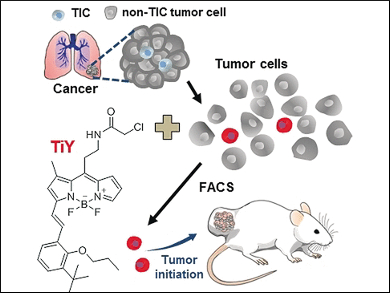Fluorescent Probe Identifies Tumor-Initiating Cells
Cells with stem-cell characteristics appear to be especially important in the formation and metastasis of tumors. Nam-Young Kang, Agency for Science Technology and Research (A*STAR), Singapore, Young-Tae Chang, A*STAR, Pohang University of Science and Technology, Korea, and Institute for Basic Science (IBS), Pohang, Korea, and colleagues have have developed a universal fluorescent probe for these “cancer stem cells”. This dye also selectively kills off the cells.
“Cancer stem cells”, also known as tumor-initiating cells (TIC), appear to cause relapses after radiation and chemotherapy because a single surviving TIC can cause a new tumor to grow. In addition, they appear to be the main cause of metastasis. Effective tumor treatment must therefore aim to kill off TICs as extensively as possible. To this end, a “probe” that marks these cancer stem cells would be useful so that they become visible. Although there are markers that also recognize TICs associated with some types of cancer, no universal selective probe for cancer stem cells has been found.
Selective Probe also Kills Cancer Cells
The researchers have succeeded in finding such a probe. They were able to show that their new probe, a fluorescent dye, selectively stains TICs from a broad variety of cancers, including tumors of the lung, central nervous system, breast, kidney, ovary, colon, and prostate, as well as melanomas. Healthy cells and “ordinary” tumor cells were not marked. At high concentrations, the dye also demonstrates considerable cytotoxicity toward TIC, while other cells are barely affected.
The team discovered that their probe, named TiY (for tumor-initiating cell probe yellow), recognizes vimentin, which is a molecule in the cytoskeleton. Vimentin is more concentrated in epithelial cells when they transform into mesenchymal cells. Epithelial cells form the tissue that covers the inner and outer surfaces of the body, forming a boundary with the environment. The cells are polar, meaning that the side facing toward the underlying tissue and the side directed outward toward the lumen are different. The cells are also firmly integrated into the cell wall. When they transform into mesenchymal cells, they lose their polarity, are freed from the cell structure, and may wander. This process plays an important role in the development of embryos and healing of wounds. It is also involved in the metastasis of tumors.
As the first fluorescent probe for TIC, TiY could be a valuable tool for the visualization and isolation of TIC, and may help in the development of tumor treatments that are targeted toward zones concentrated with vimentin, thereby inhibiting relapses.
- Identification of Tumor Initiating Cells with Small-Molecule Fluorescent Probe by Using Vimentin as a Biomarker,
Yong-An Lee, Jong-Jin Kim, Jungyeol Lee, Jia Hui Jane Lee, Srikanta Sahu, Haw-Young Kwon, Sung-Jin Park, Se-Young Jang, Jun-Seok Lee, Zhenxun Wang, Wai Leong Tam, Bing Lim, Nam-Young Kang, Young-Tae Chang,
Angew. Chem. Int. Ed. 2018.
https://doi.org/10.1002/anie.201712920




